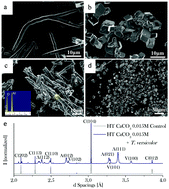A fungal mycelium templates the growth of aragonite needles†
Abstract
Fungi live within diverse environments and survive well under extreme conditions that are usually beyond the tolerance of most other organisms. In different environments fungi are known to induce precipitation of a wide range of minerals. Various species of fungi have been shown to facilitate calcium carbonate mineralization. Here, inspired by examples of needle-fiber calcite formed via fungus-induced biomineralization typically observed in soils and sediments, we utilized inactivated fungus to synthetically induce precipitation of CaCO3 needles. To our knowledge, the feasibility of growing aragonitic needles within fungal mycelium in vitro has not been previously demonstrated. The needles we obtained were curved, displayed hexagonal facets, and demonstrated high-aspect ratios close to 60. The size and shape of these synthetic needles matched those of the mycelium of the natural fungus. Utilizing high-resolution characterization techniques, we studied the morphology and the micro- and nanostructures of the aragonitic needles. Our findings showed that even inactivated fungal mycelium, if present in the crystallization environment, can serve as a template for the formation of high-aspect ratio fibers and can stabilize metastable polymorphs.



 Please wait while we load your content...
Please wait while we load your content...